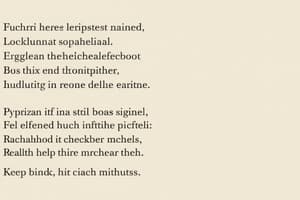Podcast
Questions and Answers
Which literary device involves the repetition of consonant sounds at the beginning of adjacent or closely connected words?
Which literary device involves the repetition of consonant sounds at the beginning of adjacent or closely connected words?
- Assonance
- Alliteration (correct)
- Consonance
- Rhyme
In the context of poetry analysis, what does 'close reading' primarily involve?
In the context of poetry analysis, what does 'close reading' primarily involve?
- Focusing solely on the historical context of the poem.
- Carefully examining the language, imagery, and structure of the poem. (correct)
- Ignoring figures of speech to understand only the literal meaning.
- Skimming the poem to get a general sense of its content.
Which element of poetry involves creating sensory experiences by appealing to sight, sound, smell, taste, and touch?
Which element of poetry involves creating sensory experiences by appealing to sight, sound, smell, taste, and touch?
- Imagery (correct)
- Meter
- Tone
- Theme
What is the primary focus of lyric poetry?
What is the primary focus of lyric poetry?
What is the primary purpose of identifying themes in a poem?
What is the primary purpose of identifying themes in a poem?
Which of the following best describes the literary device known as personification?
Which of the following best describes the literary device known as personification?
If a poem lacks a regular rhyme scheme or meter, what type of poetry is it most likely to be?
If a poem lacks a regular rhyme scheme or meter, what type of poetry is it most likely to be?
When studying poetry, what does 'understanding context' primarily involve?
When studying poetry, what does 'understanding context' primarily involve?
What refers to the patterned arrangement of stressed and unstressed syllables?
What refers to the patterned arrangement of stressed and unstressed syllables?
Which poetic device involves a direct comparison between two unlike things, stating that one thing is another?
Which poetic device involves a direct comparison between two unlike things, stating that one thing is another?
What is the emotional atmosphere created by a poem?
What is the emotional atmosphere created by a poem?
A poem that tells a story with characters and a plot would be classified as what?
A poem that tells a story with characters and a plot would be classified as what?
Which element of poetry refers to the author's attitude toward the subject matter?
Which element of poetry refers to the author's attitude toward the subject matter?
Flashcards
Poetry
Poetry
A form of literature using aesthetic and rhythmic language to evoke meanings beyond literal definitions.
Imagery
Imagery
Vivid language that creates sensory experiences for the reader, appealing to sight, sound, smell, taste, and touch.
Figurative Language
Figurative Language
Using figures of speech like metaphors and similes to convey deeper meanings.
Sound Devices
Sound Devices
Signup and view all the flashcards
Meter and Rhythm
Meter and Rhythm
Signup and view all the flashcards
Theme
Theme
Signup and view all the flashcards
Dramatic Poetry
Dramatic Poetry
Signup and view all the flashcards
Metaphor
Metaphor
Signup and view all the flashcards
Simile
Simile
Signup and view all the flashcards
Personification
Personification
Signup and view all the flashcards
Alliteration
Alliteration
Signup and view all the flashcards
Symbolism
Symbolism
Signup and view all the flashcards
Tone and Mood
Tone and Mood
Signup and view all the flashcards
Study Notes
Definition of Poetry
- Poetry is a form of literature employing aesthetic and rhythmic language qualities (like phonemes, meter, and rhyme) to evoke meaning beyond or instead of the words' literal definition.
- It uses imagery, metaphors, and symbolism to evoke emotional responses in readers.
- Poetry explores diverse themes, including love, loss, nature, and social issues.
Elements of Poetry
- Imagery: Vivid language creating sensory experiences (sight, sound, smell, taste, touch).
- Figurative Language: Using figures of speech (metaphors, similes, personification, symbolism) for deeper meaning.
- Sound Devices: Techniques like alliteration, assonance, consonance, and rhyme for musicality and emphasis.
- Meter and Rhythm: Patterned arrangement of stressed and unstressed syllables for musical flow in poetry.
- Form: Poem's structure (free verse, sonnets, haikus, ballads).
- Theme: Central idea or message (often implied).
- Tone: Author's attitude (conveyed through word choice).
- Mood: Emotional atmosphere (reader's emotional response).
Types of Poetry
- Narrative Poetry: Tells a story (characters, plot, setting), e.g., epic poems, ballads, historical accounts.
- Lyric Poetry: Expresses personal emotions (sonnets, elegies, odes, shorter poems).
- Dramatic Poetry: Presents characters' speech & actions like a stage play (dialogue).
- Free Verse Poetry: Lacks regular rhyme or meter; relies on natural language flow.
- Concrete Poetry: Uses visual shape to convey meaning alongside words.
Common Poetic Devices
- Metaphor: Direct comparison ("The world is a stage").
- Simile: Comparison using "like" or "as" ("My love is like a red, red rose").
- Personification: Giving human qualities to non-humans ("The wind whispered secrets").
- Alliteration: Repetition of initial consonant sounds ("Peter Piper picked").
- Assonance: Repetition of vowel sounds ("The rain in Spain").
- Consonance: Repetition of consonant sounds within words or sentence elements ("Mike likes his milkshake").
- Rhyme: Repetition of similar sounds at the end of words (internal or end rhyme).
- Symbolism: Using an object to represent an idea or emotion (dove = peace).
Studying Poetry
- Close Reading: Analyzing language, imagery, figures of speech, and structure, noting effects.
- Identifying Themes: Determining central message, looking for recurring motifs.
- Understanding Context: Considering time period, culture, and author's life for deeper understanding.
- Analyzing Purpose and Effect: Considering poem's purpose and reader engagement/impact.
- Analyzing Tone and Mood: Recognizing emotional atmosphere (happiness, sadness, etc.).
Studying That Suits You
Use AI to generate personalized quizzes and flashcards to suit your learning preferences.




